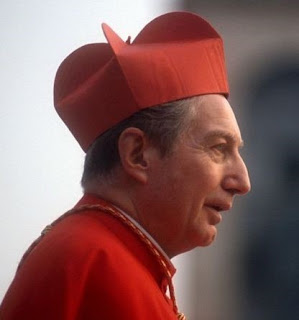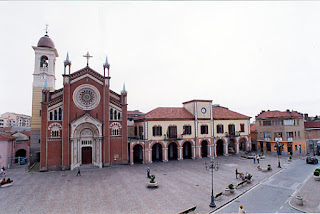The first Italian author of gialli to be accepted by Mondadori
 |
| Varaldo's Il sette bello was the first giallo by an Italian |
His character, the police commissario Ascanio Bonichi, made his first appearance in Varaldo’s novel Il sette bello - the name by which Italians refer to the seven of diamonds in a deck of cards - which was published by Mondadori in 1931.
The author had been approached by Arnaldo Mondadori himself and encouraged to create a novel in Italian to appeal to the readers who were already eagerly buying their gialli, the Italian translations of English, American and French detective novels that the firm published.
Gialli take their name from the distinctive yellow - giallo in Italian - covers used by Mondadori for their crime novels in the 1930s.
Varaldo was born in Ventimiglia in Liguria in 1873 and grew up to become a journalist, novelist and playwright. From 1910 onwards he wrote novels, short stories and plays and contributed to newspapers such as Gazzetta del Popolo and Il Caffaro.
He was president of the Italian Society of Authors and Publishers between 1920 and 1928 and director of the Academy of Dramatic Art in Milan from 1943.
In 1931, the Italian Government had brought in measures to try to curb the number of translated books by foreign authors being published, which encouraged Varaldo, along with other authors at the time, to try his hand at the genre.
 |
| Varaldo, who was also a journalist, wrote seven other gialli in addition to Il sette bello |
He portrayed Bonichi as a down to earth character from the countryside who solved his cases by chance, rather than using the more scientific methods employed by other fictional detectives such as Sherlock Holmes.
His novels were set in Rome before the war and described the city’s Baroque and neo-Baroque buildings, which formed a theatrical background during the night and at dawn, when the silhouette of a figure could be illuminated. Crime fiction experts think this evoked an irretrievable past for his readers to escape to.
Varaldo wrote a total of eight gialli between 1931 and 1938 and he also wrote some drammi gialli -detective plays - before his death.
Travel tip:
Ventimiglia, where Alessandro Varaldo was born, is the last major town on the Italian riviera before the border with France, which is about 6km (3.7 miles) away. Situated about 130km (81 miles) west of the Ligurian capital Genoa, it is not a well known as nearby Sanremo but has plenty going for it, nonetheless, its charm enhanced by the pastel colours of its houses. The town is divided in two by the Roia river, which separates the newer lower town from the old upper town - Ventimiglia Alta - which sits on a hill encircled by walls. Ancient buildings and churches dating back to the 10th century make the climb worthwhile, as does the spectacular view over the Ligurian sea. The mediaeval old town is also home to the Biblioteca Civica Aprosiana - founded by the writer and Augustan monk Angelico Aprosio in 1648 - has one of the largest collections of 17th century manuscripts and books in Italy. The elegant lower town is best known for the massive open-air market that takes place in the beautiful setting of the lungomare - the promenade - every Friday. There are a smaller number of stalls open on the other days of the week. For beach lovers, the Spiaggia dei Balzi Rossi and the Spiaggia delle Calandre are only a short walk from the centre.
Travel tip:
The Mondadori publishing house, whose Gialli Mondadori broke new ground in publishing in Italy as the first book series to feature detective and crime stories alone, was launched in Ostiglia, an historical town about 160 km (99 miles) southeast of Milan and about 30 km (19 miles) from Mantua. In Roman times, when it was called Hostilia, its location on the Via Claudia Augusta Padana saw it become a trade hub linking Emilia with northern Europe. In the Middle Ages it was a stronghold of Verona before being acquired in turn by the Scaliger, Visconti and Gonzaga families. The Palazzina Mondadori, an elegant Art Nouveau-style building that was the first Arnoldo printing house, hosts Arnoldo Mondadori’s private library consisting of about 1,000 books, many signed by the authors. Mondadori relocated to Milan in 1929 and now boasts a modern headquarters in the suburb of Segrate, to the east of the centre.
More reading:
How Giorgio Mondadori helped launch the newspaper La Repubblica
Why Augusto De Angelis is regarded as the 'father of Italian crime fiction'
The Naples bank worker who became a leading modern crime writer
Also on this day:
1455: The birth of painter Fra Angelico
1564: The death of painter and sculptor Michelangelo
1626: The birth of biologist Francesco Redi
1967: The birth of footballer Roberto Baggio
1983: The birth of tennis champion Roberta Vinci

.jpg)



.jpg)















%2016,%20villa%20Rodolfo%20Mauri%20(Carlo%20Moroni%20con%20Filippo%20Tenconi)%20(2).jpg)







.jpg)


.jpg)
